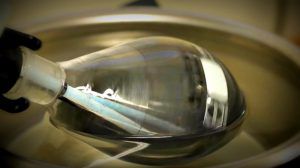ANU scientists have developed a new material based on graphene that could drive a revolution in medical implants and lightweight heat-resistant materials for car and aircraft engines.
The new plastic material has the heat resistance of some metals but is much lighter, said co-lead researcher Associate Professor Shannon Notley, from The Australian National University (ANU).
“The combination of strength and electrical properties is as good as anyone’s made before, and it’s stable at very high temperatures,” Shannon said.
“The team also demonstrated the new material’s potential for medical applications by growing a layer of mammalian cells on it.
“This material’s ability to merge into the body will greatly improve outcomes for implants.
“It could also be crucial for the development of tiny sensors implanted in the body and could even be used for fuel cells based on bacterial interactions found in nature.”
The research is published in Advanced Materials Interfaces.
Graphene is a form of carbon made of layers a single atom thick, which has extremely high electrical and heat conduction. Taking advantage of these properties at a large scale requires making composite materials that link many graphene sheets, which has until now has required expensive and toxic solvents because graphene is not water soluble.
The team developed a way to produce graphene using a designer surfactant, a chemical that works similarly to the way soap dissolves grease in water.
As well as suspending the graphene, the surfactant molecules were engineered to link together to form a polymer, said their designer and co-lead author, Dr Tao Wang, from Swinburne University Department of Chemistry and Biotechnology, and ANU RSPE.
“Because the chemical we use to suspend the graphene becomes the matrix, it takes out a couple of steps and makes the manufacturing much quicker and easier,” Tao said.
“Usually the surfactant is an intermediate chemical you have to get rid of before you cross link the polymer, which is a headache. But ours is implicitly involved in forming the composite.”
“The new understanding of molecular mechanisms developed in this research will enable us to tailor chemicals to get the properties they need.
“It’s a unique system, it’s opening up a whole new way of making nanocomposites.
Who can be trusted?
In a world of spin and confusion, there’s never been a more important time to support independent journalism in Canberra.
If you trust our work online and want to enforce the power of independent voices, I invite you to make a small contribution.
Every dollar of support is invested back into our journalism to help keep citynews.com.au strong and free.
Thank you,
Ian Meikle, editor





Leave a Reply